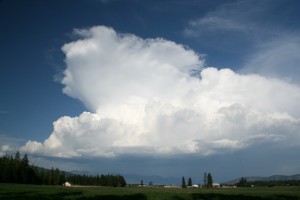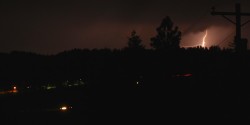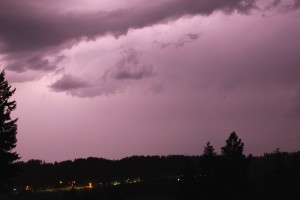Flash, boom, rumble. The night sky lights up for an instant before the booming thunder overpowers all other noises. Again and again, the lightning and thunder flash and boom until the thunderstorm passes over.
While thunderstorms can occur year round, they are most common in spring and summer in the afternoon and evening because of unstable air. The hot air rising from the Earth’s surface creates unstable air masses visible in the form of cumulonimbus clouds.
The rapidly growing towering thunderheads create an imbalance of electrical discharge that is responsible for lightning. In the cumulonimbus cloud, rising ice crystals and falling hail collide and free electrons. The ice crystals gain a positive charge and rise to the top of the cloud through convection while the hail assumes a negative charge and sink to the bottom of the cloud.
Only an electric current, in the form of lightning, between the two charged areas can balance the difference. Lightning within a cloud is called intracloud lightning and is the most common type of lightning.
Cloud-to-ground lightning occurs because the bottom of the thundercloud is negatively charged and the ground is positively charged beneath the cloud. The lightning begins by negative charges racing towards the ground (at about 200,000 mph) through a channel which is called a “stepped leader”.
As the stepped leader approaches the ground, positive charges rise through trees, buildings or people to meet the leader. These positively charged channels are called streamers.
When the leader and the streamer meet, a negatively charged electrical current rapidly flows from the cloud to the ground and a visible flash of lightning streaks upwards through the channel at 200,000,000 mph. While lightning may appear to strike downward, we are actually seeing the return stroke of light streaking upwards. The entire process is completed in about 200 milliseconds.
Each bolt of lightning can contain up to one billion volts of electricity and is extremely hot. During a flash of lightning, the air around the channel of electrical current can be heated to temperatures five times hotter than the sun’s surface, causing the air to rapidly expand and vibrate. This vibration is the thunder we hear.
Even though lightning and thunder occur at the same time, we see lightning before we hear thunder because light travels faster than sound. A good estimate on how far away a storm is from you is the difference in seconds between the lightning and thunder. For every five second difference between seeing lightning and hearing thunder, the storm is one mile away.
Lightning can strike more than 10 miles away from a cumulonimbus cloud through “positive lightning”. Positive lightning is a type of cloud-to-ground lightning that originates in the positively charged top of the thundercloud. The positive charged stepped leader seeks out negatively charged ground away from the storm cloud (since underneath the storm the ground is positively charged). The reverse flow of negative current from the ground to the cloud is stronger and more destructive than regular cloud-to-ground lightning.
If you can hear thunder, there is danger of a lightning strike nearby so seek shelter. Thunder can be heard up to 15 miles away in quiet areas. Lightning can be seen 100 miles away, which allows for some spectacular storm watching at night when a line of thunderstorms is passing nearby.






